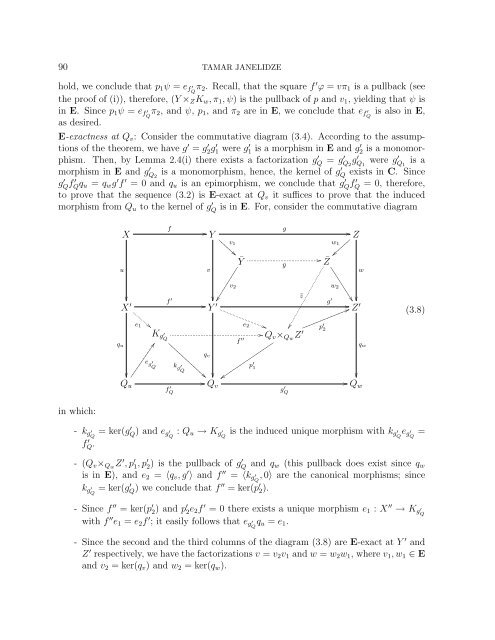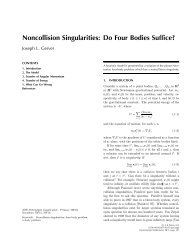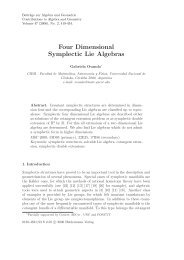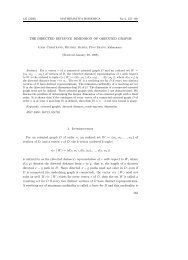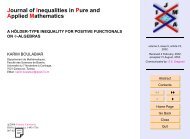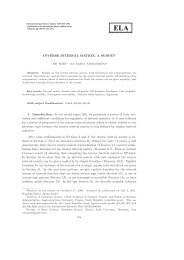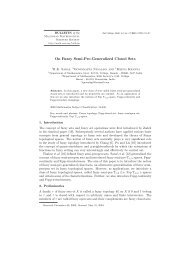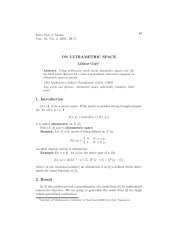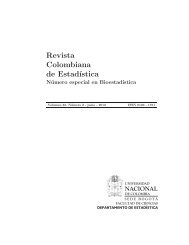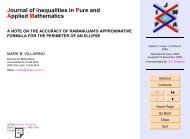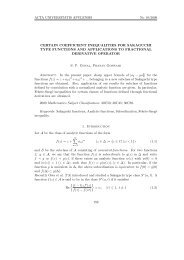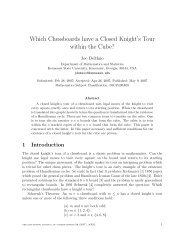SNAKE LEMMA IN INCOMPLETE RELATIVE HOMOLOGICAL ...
SNAKE LEMMA IN INCOMPLETE RELATIVE HOMOLOGICAL ...
SNAKE LEMMA IN INCOMPLETE RELATIVE HOMOLOGICAL ...
You also want an ePaper? Increase the reach of your titles
YUMPU automatically turns print PDFs into web optimized ePapers that Google loves.
90 TAMAR JANELIDZE<br />
hold, we conclude that p 1 ψ = e f ′<br />
Q<br />
π 2 . Recall, that the square f ′ ϕ = vπ 1 is a pullback (see<br />
the proof of (i)), therefore, (Y × Z K w , π 1 , ψ) is the pullback of p and v 1 , yielding that ψ is<br />
in E. Since p 1 ψ = e f ′<br />
Q<br />
π 2 , and ψ, p 1 , and π 2 are in E, we conclude that e f ′<br />
Q<br />
is also in E,<br />
as desired.<br />
E-exactness at Q v : Consider the commutative diagram (3.4). According to the assumptions<br />
of the theorem, we have g ′ = g 2g ′ 1 ′ were g 1 ′ is a morphism in E and g 2 ′ is a monomorphism.<br />
Then, by Lemma 2.4(i) there exists a factorization g Q ′ = g′ Q 2<br />
g Q ′ 1<br />
were g Q ′ 1<br />
is a<br />
morphism in E and g Q ′ 2<br />
is a monomorphism, hence, the kernel of g Q ′ exists in C. Since<br />
g Q ′ f Q ′ q u = q w g ′ f ′ = 0 and q u is an epimorphism, we conclude that g Q ′ f Q ′ = 0, therefore,<br />
to prove that the sequence (3.2) is E-exact at Q v it suffices to prove that the induced<br />
morphism from Q u to the kernel of g Q ′ is in E. For, consider the commutative diagram<br />
in which:<br />
f<br />
g<br />
X<br />
Y <br />
Z<br />
v 1 w 1<br />
<br />
<br />
Ȳ<br />
<br />
ȳ<br />
¯Z <br />
u<br />
v<br />
<br />
w<br />
<br />
<br />
<br />
v 2<br />
w 2 <br />
<br />
<br />
<br />
¯z<br />
<br />
X ′<br />
f ′ Y ′ g ′<br />
Z ′ (3.8)<br />
e 1<br />
e 2 <br />
K g ′ <br />
Q<br />
Q<br />
q u<br />
f ′′ v × Qw Z ′<br />
p ′ 2<br />
<br />
q w<br />
q v<br />
e g ′<br />
k g ′ p ′ Q 1<br />
Q<br />
<br />
<br />
Q u<br />
Q<br />
f Q<br />
′ v<br />
Q w<br />
- k g ′<br />
Q<br />
= ker(g ′ Q ) and e g ′ Q : Q u → K g ′<br />
Q<br />
is the induced unique morphism with k g ′<br />
Q<br />
e g ′<br />
Q<br />
=<br />
f ′ Q .<br />
- (Q v × Qw Z ′ , p ′ 1, p ′ 2) is the pullback of g ′ Q and q w (this pullback does exist since q w<br />
is in E), and e 2 = 〈q v , g ′ 〉 and f ′′ = 〈k g ′<br />
Q<br />
, 0〉 are the canonical morphisms; since<br />
k g ′<br />
Q<br />
= ker(g ′ Q ) we conclude that f ′′ = ker(p ′ 2).<br />
g ′ Q<br />
- Since f ′′ = ker(p ′ 2) and p ′ 2e 2 f ′ = 0 there exists a unique morphism e 1 : X ′′ → K g ′<br />
Q<br />
with f ′′ e 1 = e 2 f ′ ; it easily follows that e g ′<br />
Q<br />
q u = e 1 .<br />
- Since the second and the third columns of the diagram (3.8) are E-exact at Y ′ and<br />
Z ′ respectively, we have the factorizations v = v 2 v 1 and w = w 2 w 1 , where v 1 , w 1 ∈ E<br />
and v 2 = ker(q v ) and w 2 = ker(q w ).


